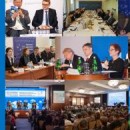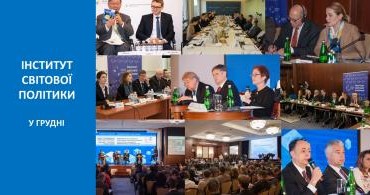Article by Kateryna Zarembo, Deputy Director of the Institute of World Policy for the Euro-Atlantic Quarterly2011 celebrates two years since the launch of Eastern Partnership (EaP) in Prague. Be it much or little for geopolitics, the project is still a toddler, bringing little added value to the state of international relations in the region. While it was Russia who gave impetus to Eastern Partnership – the Russian-Georgian war in August 2008 was a signal to some EU Member States that the region required special attention – the initiative lacked security or geopolitical dimension from the start. Its four platforms, democracy, good governance and stability; economic integration and convergence; energy security and people-to-people contact were an innocent and feeble carrot, which some Eastern partners like Ukraine did not even take seriously.
However, Russia was unhappy about the Eastern Partnership. Russian Prime Minister Vladimir Putin called the EaP “an alternative to NATO’s expansion to the East”, while President of Russia Dmitry Medvedev warned the EU that the program should not be aimed “against Russia”. Russia was also bewildered by the fact that, together with covering Ukraine, Moldova and Georgia, European-oriented countries, the EaP embraced Belarus and Armenia, the long-standing Russian allies. Moscow refused to take part in the EaP and to finance joint projects on the ground of “non-transparent decision-making and unclear content of the EaP”. Thus, instead of eliminating the security vacuum in the region, the benevolent idea of European ministers Radoslaw Sikorski and Carl Bildt added up to it.
In fact, Russia has nothing to worry about. Let’s face it: the region is no priority to the EU. The European Security Strategy Review of 2008 only brushes upon the Eastern Partnership, declaring the goal of strengthening “the prosperity and stability of these countries, and thus the security of the EU”. In contrast, it describes the Mediterranean as “an area of major importance and opportunity for Europe” and admits that “Europe has security interests beyond its immediate neighbourhood”. The first EaP summit in Prague was ignored by the heads of France, Italy, Spain, the UK, Austria, Portugal, Malta and Cyprus. The third summit has been postponed from May 27, 2011 to some time in autumn due to the fact that France is organizing a G8 summit on that date.
Another fact to admit is that the EaP funding is laughable. The budget of € 600 mio for 2009-2013 has been criticized by many, including the European Parliament in its freshly released resolution on the EaP. The gross inadequacy of the sum is illustrated by an example of what the EU can do if it really cares: in March 2010 an International Donor’s Forum convened in Chisinau at the initiative of the European Commission and the World Bank. As a result, Moldova got € 1.9 bn, 52% of which comes as a grant and 48% as a loan at 1,2% interest rate. This fact proves that the countries covered by the EaP are not disinteresting for the EU per se. Rather, the EaP is ill-equipped to bring about substantial change. At the Ministerial meeting of Visegrad countries and Germany in Bratislava in March 2011 the officials called for the adequate financing of EU policy towards the Eastern partners in the next Multi-Annual Financial Perspective.
Finally, the democratic performance in all countries covered by the EaP has deteriorated rather than improved. One EU Member State diplomat has acknowledged: many leaders in the EU admit the fiasco of their Eastern Policy.
In 2010 Russia opted to reject participation in the Group of Friends of the Eastern Partnership, an informal initiative launched by Poland last year. However, it suggested that it would have “an observer status” in this Group. In other words, Kremlin remains vigilant.
Russian officials agree that they would not mind working with the EU on a joint project vis-à-vis the EaP if Russia could co-author the project rather than join an existing initiative. In particular, spheres like transport and energy are attractive to Moscow. Still, Russia is skeptical about the EU’s genuine interest in such initiatives and in the region as such.
Russia certainly does not perceive the Eastern Partnership as a threat anymore because the European Union does not apply the EaP as a package approach to the region. The pace of the European integration in each of the EaP countries is unique. On the other hand, the bilateral relations of the EU with individual EaP countries can well provoke Russian ire.
The Eastern Partnership offers some key initiatives: association agreements (AA), comprehensive institution building programs, deep and comprehensive free trade areas (DCFTA) and visa liberalization. In particular, Ukraine is nearing the end of painful negotiations on the AA and DCFTA, with the last round presumably taking place in June. In reply Moscow has launched a powerful campaign for making Ukraine join the Customs Union with Russia, Belarus and Kazakhstan instead. Russia’s Deputy Prime Minister Igor Shuvalov specially came to Ukraine in order to talk the Ukrainian officials out of DCFTA. Russian Prime Minister Vladimir Putin followed shortly after, allegedly for the same purpose. Otherwise, Moscow admits, it will have to “raise the barriers” for trade with Ukraine.
Nevertheless, Russian diplomats assure: the EU-Russia relations would remain intact. This is the evidence of Russian power-oriented policy: you can only speak with strong partners on equal terms. The EU is a strong partner and deserves respect. Ukraine is not.
In fact, Russian relations with the EU can be considered better than that of the EU with its EaP partners. Last year Russia and the European Union launched a Partnership for Modernization – a plan to share state-of-the-art EU technology and democratic standards with Russia. It is engaged in creating the European security architecture: Poland, who is bent on reviving the EaP under its EU Presidency in the second half of 2011, is going to hold a summit with France, Germany and Russia in order to talk about the EU’s “ostpolitik”. Besides, Russia is not completely excluded from the EaP initiatives: it takes active part in the visa liberalization dialogue on a par with such frontrunners as Ukraine and Moldova, has lower refusal rate in Schengen visas than Ukraine and Moldova and even lobbies for getting the visa-free regime ahead of these countries.
In the EU case Russia is dissatisfied with other things. For example, in 2010 Germany suggested to Russia to withdraw its troops from Transnistria in exchange for possibly establishing a Russia-EU Committee on Foreign Policy and Security. Russian diplomats were unhappy about the prospect of losing its strategic influence asset in exchange for something ephemeral and uncertain. But the Eastern Partnership has nothing to do with it: as mentioned above, security issues are beyond its scope.
So, until the Eastern Partnership remains a convenient name for the region rather than a substantive project, Russia has nothing to worry about. Meanwhile, it can set the EU an example of how to deal with the neighbours, including in financial terms: by the end of 2011 Russia is going to launch its own foreign aid fund, created after Western aid projects like USAID. Unlike the EU, Russia’s intentions towards the region are serious.
Still, money is not everything. Moral support and a clear indication of the fact that EU-oriented countries like Ukraine are welcome and supported by the EU mean a great deal for their leaders and people. Whether the EU will choose to do so, is yet to see. But if it is looking for cost-effective revive of its Eastern policy, such approach is definite value for money.
Publication

The EU, Russia and Eastern Partners: who is the odd one out?
12:57 PM 22-7-2011



Comments theme
Comments themeComments themeComments themeComments themeComments themeComments themeComments themeComments themeComments themeComments themeComments themeComments themeComments themeComments themeComments themeComments themeComments themeComments themeComments themeComments.